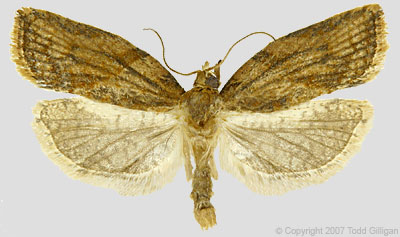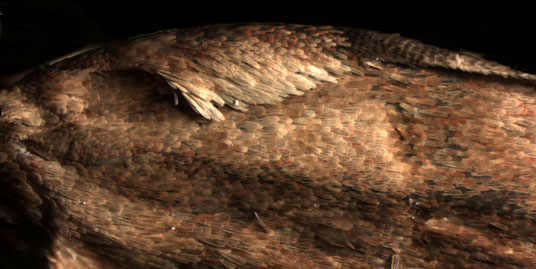|
Light Brown Apple Moth (Epiphyas postvittana) Screening Aid
S. Passoa¹, T. M. Gilligan², and M. Epstein³

Updated May 2008
NEW! Updated screening aid for LBAM
We have expanded the original screening aid and coverted it to PDF format for easier printing. The latest version
of the screening and identification aid can be found here. This is the same version that will be used by screeners
for the USDA's LBAM National Survey:
LBAM Screening and Identification Aid
KEY TO SCREEN LBAM SUSPECTS IN THE UNITED STATES
This screening aid is designed to help screen light brown apple moth (LBAM) specimens collected
in the United States. The two most common methods of survey are sticky traps and light traps. Sticky
traps normally capture only males, although California LBAM traps capture female tortricids more often
than expected. Light traps capture either males or females but not always in equal numbers. Both
male and female genitalia are illustrated in order to to help members of the CAPS program recognize
this pest regardless of the sex of the specimens.
| 1. Abdominal or thoracic tympanum present; antenna pectinate; labial palpi
upturned; proboscis scaled or absent; moths not about 7-12 mm long |
Not LBAM |
| 1'. Abdominal and thoracic tympanum absent; antenna simple; labial palpi
pointed and projecting forward; proboscis not scaled; moths about 7-12 mm long |
2

|
| 2. Chaetosema absent |
Not LBAM |
| 2'. Chaetosema present or condition unknown |
3

|
| 3. Males |
4 |
| 3'. Females |
6

|
| 4. Costal fold absent; uncus tubular |
Not LBAM |
| 4'. Costal fold present; uncus spatulate |
5

|
| 5. Membranous lobe from apex of valve absent |
Not LBAM |
| 5'. Membranous lobe from apex of valve present |
LBAM Suspect

|
| 6. Ductus bursae in a spiral; signum absent |
Not LBAM |
| 6'. Ductus bursae straight, never in a spiral; signum present |
7

|
| 7. Ductus bursae no more than 2-3 times as long as the corpus bursae
and entire bursae 1/2 the length of the abdomen or less |
Not LBAM |
| 7'. Ductus bursae 4-5 times as long as the corpus bursa and entire bursae
(ductus + corpus bursae) at least 2/3 length of abdomen |
LBAM Suspect

|
Notes:
Couplet 1. Since LBAM is in the Tortricidae, it will have characteristics of that family.
No tympanum is present. The antennae are never pectinate (feathery). The labial palpi are pointed
and project forward. Unlike Gelechioidea and Pyraloidea the proboscis (tongue) is not scaled.
Size is also a useful character. Measured from the head to the wing tips, unspread on a sticky trap,
the LBAM is about 7-12 mm long (forewing length). Moths much smaller or larger than this can be discarded as not LBAM.
In California, crambid moths in the genus Achyra are often captured. Based on previous
surveys in the Eastern United States in the 1990's, LBAM traps have commonly captured a species of
Pyrausta. Therefore it is particularly important to understand how to separate
Crambidae from Tortricidae in any LBAM survey.
Couplet 2. If the chaetosema are clearly absent, this can be used to rule out the moth as a LBAM.
If chaetosema are present, or the user is unsure of this difficult character, it is best to proceed
with LBAM as a possibility.
Couplet 3. If you cannot see the frenulum bristles, moths can be sexed by looking at the tip of
the abdomen (you may need to brush the scales off). Males have a slit where the valves meet. Females
have hairy ovipositor lobes.
Couplet 4. The costal fold is a sexual character in tortricids, found only in the males of some
species, including LBAM (see photo below). If it is absent (in a male specimen), LBAM can be ruled out. The uncus is
spatulate (spoon shaped) in the LBAM but also a few common non-target tortricids
(Choristoneura rosaceana and many Clepsis species).
Couplet 5. It is best to send forward any specimen with a membranous lobe on the valve.
Couplet 6. Females are hard to screen. LBAM has a long straight ductus bursa and a hook-shaped signum
in the corpus bursae, but this combination is not unique. A common non-target in California, Clepsis peritana
(garden tortrix), has a spiral ductus bursae; this character can often be seen through the abdomen if the scales
are brushed off in alcohol or a cleaning agent in order to remove the sticky trap glue.
HOW CAN LBAM BE CONFIRMED?
A genitalic dissection is necessary to confirm the identity of this phenotypically variable species.
The male LBAM can be recognized by the large membranous lobe extending laterally from the apex of the
valve (Dugdale et al. 2005). In addition, the base of the uncus is only slightly narrowed.
Powell (1964) reports Clepsis virescana as having a weak membranous lobe on the apex
of the valve; however, this lobe is much smaller than that of the LBAM and virescana males lack
a costal fold. Dugdale et al. (2005) mentions the
shape of the costal fold as a potential character, but similarity to other species (like C. rosaceana)
limits its usefulness by non-specialists. Details of the female genitalia are best left to specialists.
LBAM GENITALIA PHOTOS
LBAM ADULT PHOTOS
Male costal fold:

Adult wing pattern variation (only a few examples):

Above photos courtesy of Natasha Wright, Florida Department of Agriculture and Consumer Services
LITERATURE CITED
Dugdale, J.S., Gleeson, D., Clunie, L.H., Holder, P.W. 2005 A diagnostic guide to Tortricidae encountered
in field surveys and quarantine inspections in New Zealand: Morphological and molecular characters.
National Plant Pest Reference Laboratory. 161 pp.
Powell, J.A. 1964. Biological and taxonomic studies on tortricine moths, with reference to the
species in California. University of California Publications in Entomology. Volume 32. 317 pp.
¹ USDA/APHIS/PPQ. Museum of Biodiversity, The Ohio State University. 1315 Kinnear Road. Columbus, OH 43212
² Colorado State University, Bioagricultural Sciences and Pest Management. C129 Plant Sciences Building.
Fort Collins, CO 80523
³ Plant Pest Diagnostics Branch, California Department of Food & Agriculture. 3294 Meadowview Road.
Sacramento, CA 95832
|
